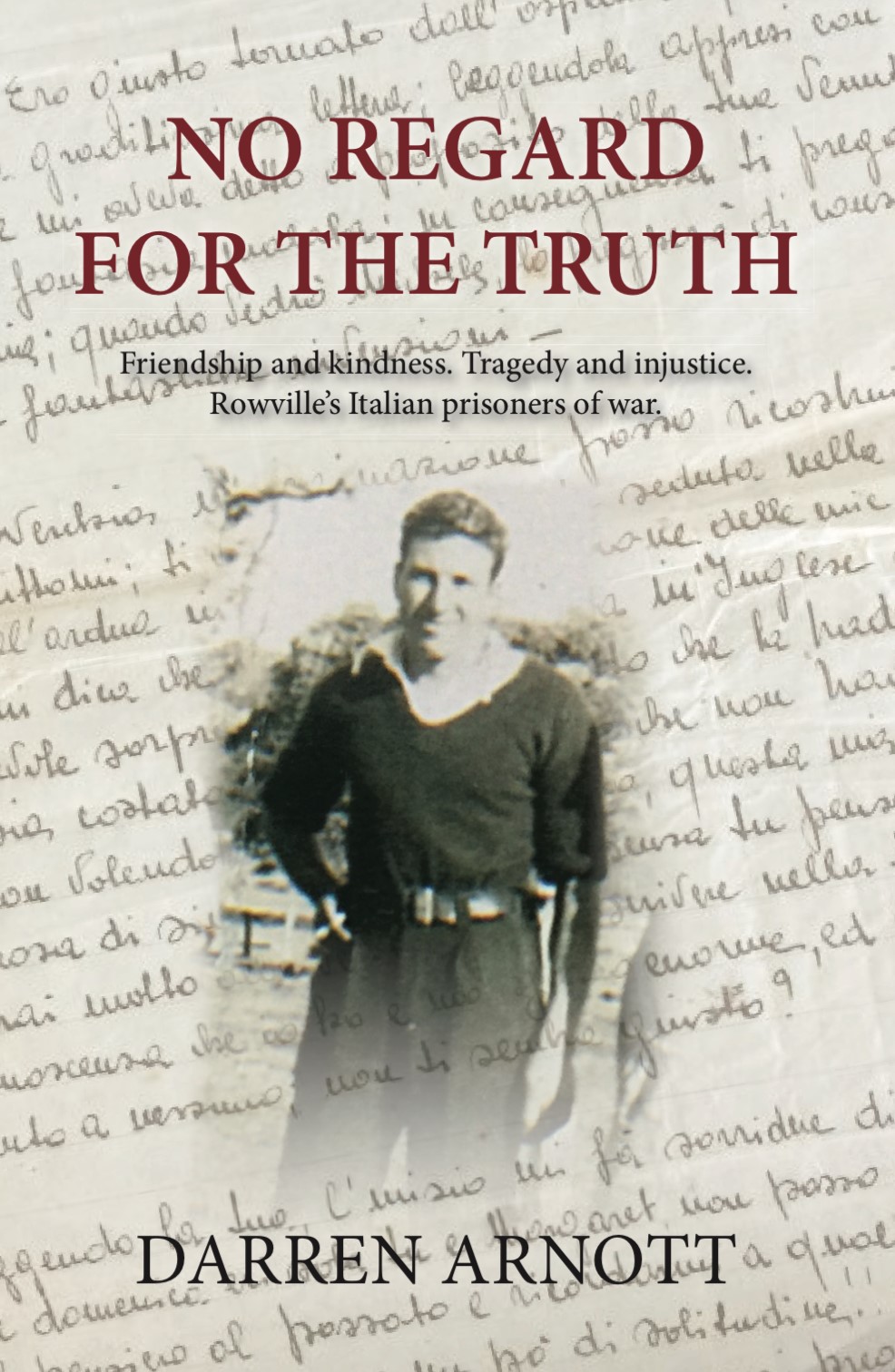In March 1946, the war was over. The Italian prisoners of war who had been captured several years earlier in northern Africa were interned in camps around Australia and were waiting to be returned home. One Saturday evening, the commandant of the Rowville internment camp, Captain Waterston, shot and killed a prisoner, Rodolfo Bartoli, who he claimed was attempting to escape. What initially appeared to be a straightforward case of an Australian army officer carrying out his duty in an attempt to prevent an Italian prisoner from escaping soon appeared to be something other. Allegations of assaults, reckless firing of weapons, drunkenness and stolen goods began to emerge. This article explores the history of the camp and follows the investigations into the shooting and the camp administration.
Walking through a small bush reserve tucked away in the middle of a suburban housing estate in Rowville, Victoria, it is possible to see the remains of concrete foundations and a section of road where an Italian prisoner of war hostel once stood. I grew up in the area and heard stories about the hostel. After rediscovering these remains several years ago, I began to do some research into the hostel. I was curious as to why Italians had been shipped all the way to Rowville, so far from their places of capture in northern Africa and the Middle East. The first item that I found at the National Archives of Australia that piqued my curiosity was a large archive box titled, ‘Shooting of Italian POW [PWI 48833 – Rodolfo Bartoli at Rowville Prisoner of War Control Hostel]’.[1] Rodolfo Bartoli, a 26-year-old Italian soldier from Florence, was shot and killed by the camp commandant, Captain Waterston, on 30 March 1946, while allegedly attempting to escape from the Rowville Italian prisoner of war hostel. The archive included the details of seven separate police, military and government inquiries into the administration of the Rowville hostel and the death of Bartoli. None of these inquiries provided a single and consistent version of events.
March 1946
World War II had ended and the approximately 18,000 prisoners who had been captured and shipped to Australia for the duration of the war were awaiting ships to become available so that they could return home.[2] An employment scheme had been implemented, allowing Italian prisoners to be employed, thereby helping with the labour shortage in Australia.[3]
Rodolfo Bartoli was one of 250 Italian prisoners housed at the prisoner of war hostel at Rowville, a small township 27 kilometres south-east of Melbourne. The Rowville hostel opened in December 1944 (see Figure 1) and, along with 24 other camps and hostels around Victoria, was overseen by the Murchison Control Centre under the supervision of Major Herbert Thomson. Many of the prisoners at the camp were employed during the day on nearby farms, at the engineer’s depot at the Oakleigh rail yards or at the salvage depot at Fishermens Bend. The Rowville hostel was used as a staging camp, a place where men were temporarily placed while being relocated to other camps throughout the state. The hostel was also used as a detention centre for prisoners with disciplinary issues. Between December 1944 and August 1946, over 2,600 Italian prisoners of war passed through the camp.[4] The Italian prisoners, in their distinctive burgundy-dyed uniforms, were a familiar sight to the local residents.
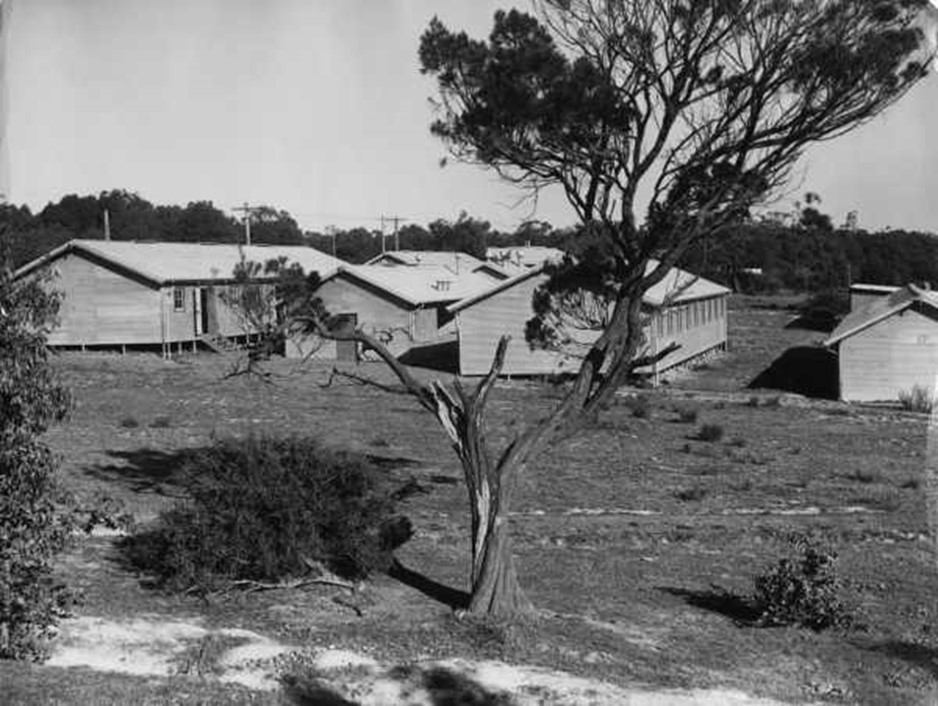
The Rowville hostel was a low security facility and, unlike other camps, was not enclosed by a wire fence or gated entrances; instead, it was surrounded by a farming fence consisting of a single strand of wire.[5] During the day the prisoners were allowed to walk around the main roads near the hostel.[6]
Bartoli, a private in the Italian infantry, was captured in Libya in December 1940 and arrived in Sydney on the Queen Elizabeth in October 1941. He was initially interned at Cowra, New South Wales, before being relocated to Murchison in August 1944. He arrived at Rowville in December 1944 and, apart from a short period of time at Koo Wee Rup and Mount Martha, spent most of his time at the Rowville camp, employed in the hostel quartermaster store.[7] He befriended a local family and developed a romantic interest in 20-year-old Nora Gearon who lived with her family on a farm near the hostel. Bartoli had a bike hidden in the banks of the nearby Dandenong Creek and, at times, used it to leave the camp. He was hoping to one day marry Nora and wrote numerous letters to her during his times away from the Rowville hostel (see Figures 2 and 3).[8]
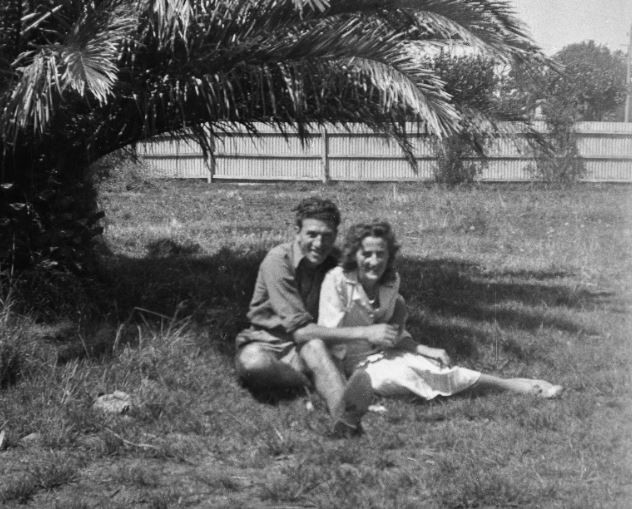
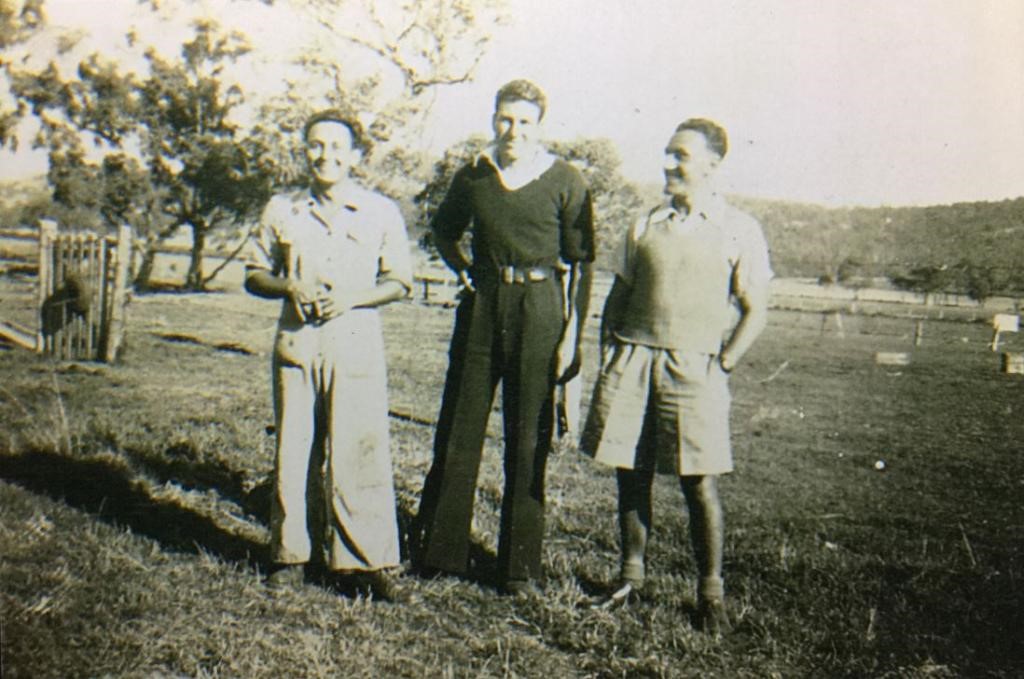
Unsettling stories about the hostel
In March 1946, Minister for Immigration Arthur Calwell received a letter of complaint from a member of the public, Louisa (Lena) Santospirito, who was a prominent campaigner for the rights of Italians and Italian immigrants.[9] The letter alleged that Captain Waterston was mistreating prisoners. Captain Waterston was referred to as a ‘veritable Nero’ in the letter and was accused of hitting prisoners, firing his weapon at them, confiscating their belongings, depriving them of food and being drunk on the job.[10] Santospirito was interviewed by Gerald Healy from the Deputy Commonwealth Crown Solicitor’s Office about her source/s of information. She said that she did not have firsthand knowledge of the issues in the camp but had received information from Mrs Ganora in Mordialloc who had been given the information from Mrs Siletta and Mrs Biletta of Oakleigh. Mrs Biletta was a cousin of one of the prisoners in the Rowville hostel, Aldo Poggi, who was a close friend of Bartoli’s.[11] Calwell forwarded the letter to Minister for the Army Frank Forde who directed the letter to the adjutant-general.[12] The letter was then forwarded for investigation to Southern Command, which was responsible for overseeing military operational and administrative matters in the region.[13]
On 27 March 1946, Major Archer was appointed to lead an investigation into the allegations against Captain Waterston.[14] This investigation had only just commenced when, on 30 March, Captain Waterston shot and killed Bartoli.
The men were eating their evening meal when a loud shot was heard. Dinner was eaten in two shifts because the number of prisoners was too high for the capacity of the mess hall. Bartoli had eaten in the first shift and had been walking with the hostel leader, Michele Scuma, when the incident took place.
With only 12 staff in the camp that night and over 200 prisoners, Captain Waterston called the civil police to assist in case of possible disruption. The provost (the military police) also arrived shortly afterwards to assist.
Bartoli was carried to the hostel infirmary where he received initial medical treatment from the camp doctor, Dr Galli. He had suffered a gunshot wound to the groin and his condition was grave. The doctor called for Captain Waterston to arrange a car to drive Bartoli directly to the Heidelberg Military Hospital where, despite undergoing surgery and a blood transfusion, he died later that night.[15]
In the confusion that took place during the evening, one prisoner, Luigi Melampo, managed to escape from the hostel (Figure 4).
In the press
The following report was published in the Herald on Monday 1 April 1946:
Facts relating to the incident were that on Saturday afternoon several prisoners of war were seen to be acting furtively. They were whispering in a group and would stop talking when guards approached. Because of the suspicion that something was brewing the 11 guards stationed with the prisoners of war were placed on duty around the headquarters section of the hostel area. At 6.30 pm, the commandant of the camp (Captain J W Waterston) saw an Italian prisoner of war, Bartoli, trying to crawl under a wire fence, apparently trying to escape.[16]
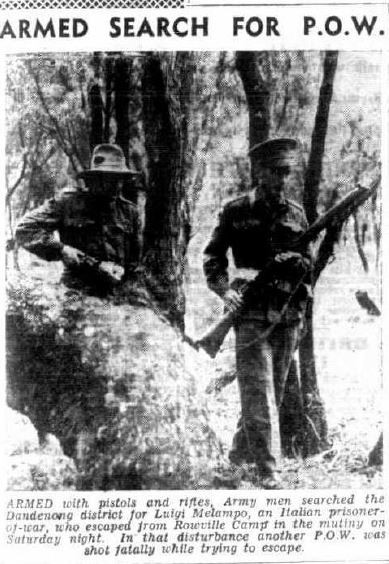
On Saturday 8 April 1946, the Truth published an outrageous article that took the story several steps further, stating that there had been a mutiny at the hostel, and that this had been part of a much wider, orchestrated escape plan (Figure 5):
Break-out by 5000 planned: Italian POW mutiny that fizzed out
Behind the planned mutiny at Rowville POW camp last weekend, which resulted in the fatal shooting of one Italian, was a scheme by which Italian prisoners-of-war at each of three main camps—Murchison, Hume and Rowville—would break free and scatter under a well-organised plan which provided for specially placed cars picking up escapees most desired by Australia’s underground Fascist movement. Those not picked up by cars were to be secreted by Italian communities and either hidden, or ‘passed on’ until they were out of danger. But the plan misfired. The Rowville mutiny was premature. By the time Rowville’s meagre guard was reinforced by civilian and military police, other POW camps harbouring Italians had been advised and they, too, were on the alert. The scheme collapsed—and it involved 5000 Italians![17]
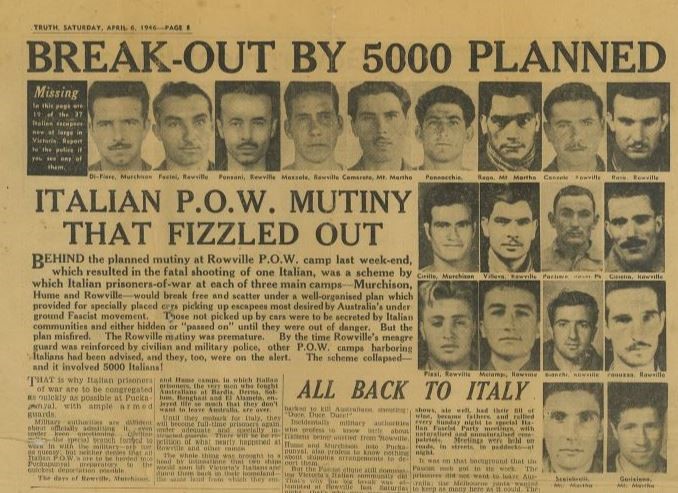
Military court of inquiry
A military court of inquiry into the circumstances leading to the shooting and death of Bartoli was held at the hostel on 5 April for the purpose of ‘inquiring into and reporting on the circumstances of the injuries sustained by PWI 48833 Bartoli Rodolfo on 30 March 1946, death of said PWI on 30 March 1946’.[18] The inquiry was presided over by Colonel Christison. Nine witnesses were heard: four military personnel, the Australian military doctor who treated Bartoli at the hospital and four Italian prisoners who helped Bartoli immediately after he had been shot.
Captain Waterston gave his account of the events of the afternoon and evening. Waterston stated that he had caught two prisoners taking lettuces from the engineer’s vegetable garden. He said that he questioned them, searched their huts and determined that there was going to be an escape attempt that evening. According to Waterston, at around dinner time, he sent two armed staff to positions along the main road outside the camp. The captain, armed with a .303 rifle, and Sergeant Major McDougall, armed with a .38 pistol, headed to the southern boundary of the camp to begin patrolling. The remaining staff stayed in the orderly room to attend to telephone duties and were instructed to draw arms from the arms chest if required.
Waterston explained to the court:
At approximately 1830 hours on the evening of 30 March 1946, I posted two guards in Stud Road. Then myself and Sergeant Major McDougall went to the south boundary of the camp and patrolled that area for the purpose of preventing PWI escaping.
At approximately 1900 hours, I saw a prisoner running for the south boundary fence. I called on him to stop. He changed his course and ran at an angle towards the scrub in a westerly direction. I ran along the boundary fence, and again called on the prisoner to stop. He kept running, and I fired a shot over his head. He did not stop, and attempting to stop him reaching the scrub, I fired another shot at his ankles. The PWI then fell, and on investigation made later, it was found that he was shot. Sergeant Major McDougall came running from the scrub, and I had ascertained by that time that the prisoner was hit. I immediately dispatched the Sergeant Major for the doctor and stretcher bearers. I went to the office and rang Heidelberg for an ambulance. I was then informed by the POW doctor that the POW should be taken to hospital immediately. He was sent in a hostel staff car and arrived at the Heidelberg Military Hospital at 1935 hours. The prisoner of war concerned was PWI 48833, Bartoli, Rodolfo.[19]
Captain Waterston was asked about the camp boundaries and he stated that the boundary was the road to the south of the camp, where the shooting had taken place, and that prisoners had been instructed in both English and Italian at least once a week that, if they were seen outside these boundaries, they were liable to be fired upon.
The court found that the death of Rodolfo Bartoli:
Resulted from his own misconduct, in that he attempted to escape and failed to halt when challenged … It was particularly noted that two warnings were given before any shots were fired … The court found that Captain Waterston, in firing on the said PWI acted properly in the execution of his military duty.[20]
Further inquiries: foolishness and larking
Even before the military court hearing, concerns had been raised about the incident at Rowville. On 1 April, the Monday after the shooting had taken place, a memo from Frank Sinclair, Minister Forde’s secretary, to Minister Forde read: ‘If the incident in regard to the shooting of the prisoner of war is read in conjunction with the allegations made by Mr [sic] Santospirito regarding this camp, it gives the incidents associated with the shooting of the prisoner of war on 31 [sic] March a rather sinister appearance.’[21] On 8 April, concerned with the allegations in the letter and the news in the press, Minister Forde announced the appointment of Justice Simpson to inquire into the administration of the hostel and the circumstances of the shooting.
On the evening following the military court of inquiry, Captain Thomson (Captain Waterston’s superior officer), Major Archer (who was conducting the inquiry into the allegations made in the letter) and Captain Waterston (accompanied by a lady friend), attended a dinner party in the officers’ mess at the hostel. During the night, several bottles of beer were consumed and two army revolvers were drawn. Shots were fired at the ceiling lights and some of the crockery. Major Thomson later stated that: ‘A silly bit of foolishness and larking occurred that night and a number of shots were fired by the Major [Archer] and I fired one shot myself.’[22]
On 10 April, a hand-drawn map of the hostel was posted outside the orderly room showing the hostel boundary (Figure 6). This replaced an older version that had been in place since the camp opened in December 1944 that showed the bridges on the main roads several kilometres from the camp as the camp boundaries.
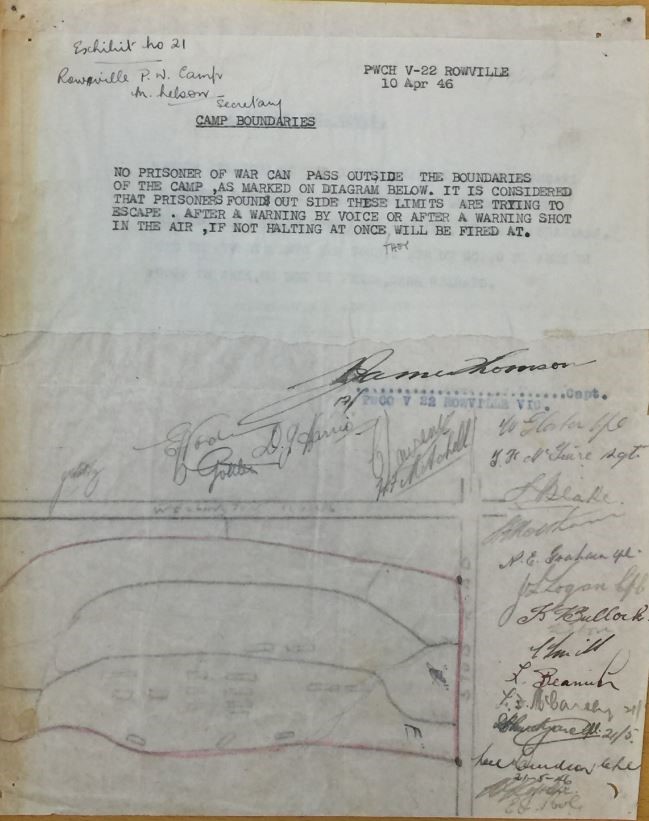
Major Archer’s findings
Major Archer’s findings were delivered on 18 April. He cleared Captain Waterston and the camp administration of any wrongdoing. The covering note accompanying his report read:
It is observed that the investigating officer has found no evidence to support the charges of habitual drunkenness and ill treatment of PW made against Capt Waterston, or the statement that food supplied to PW is very scanty. Articles confiscated from PW were found by the investigating officer to be only those items improperly in their possession and his report concludes that no legitimate grounds for complaint exist.[23]
Upon receiving the outcome from the military court of inquiry, Minister Forde responded to the secretary of the Department of the Army in a minute paper marked as urgent:
The report of the Court of Inquiry forwarded by the Adjutant-General with his minute of 24th April, 1946, is a most uninformative document and is the most unsatisfactory report of its nature that I can ever recollect having read.
The Court was called upon to report, among other things, on the circumstances under which this man sustained his injuries, including the cause of same; but the report as submitted is most indefinite and gives no real information as to the circumstance.
I assume that a full report of the Court of Inquiry will be made available to Mr Justice Simpson when he makes his investigation.[24]
The coroner’s inquest
The coroner’s hearing into Rodolfo Bartoli’s death commenced on 15 May, almost a month after Major Archer released his findings. Twenty-seven witnesses were heard, including Italian prisoners who were present when the shooting took place, military personnel from the camp, three medical staff who treated Bartoli at the hospital, homicide detectives and a local farmer (Figure 7). This was the first time that prisoners of war who had witnessed the shooting were asked to provide statements.
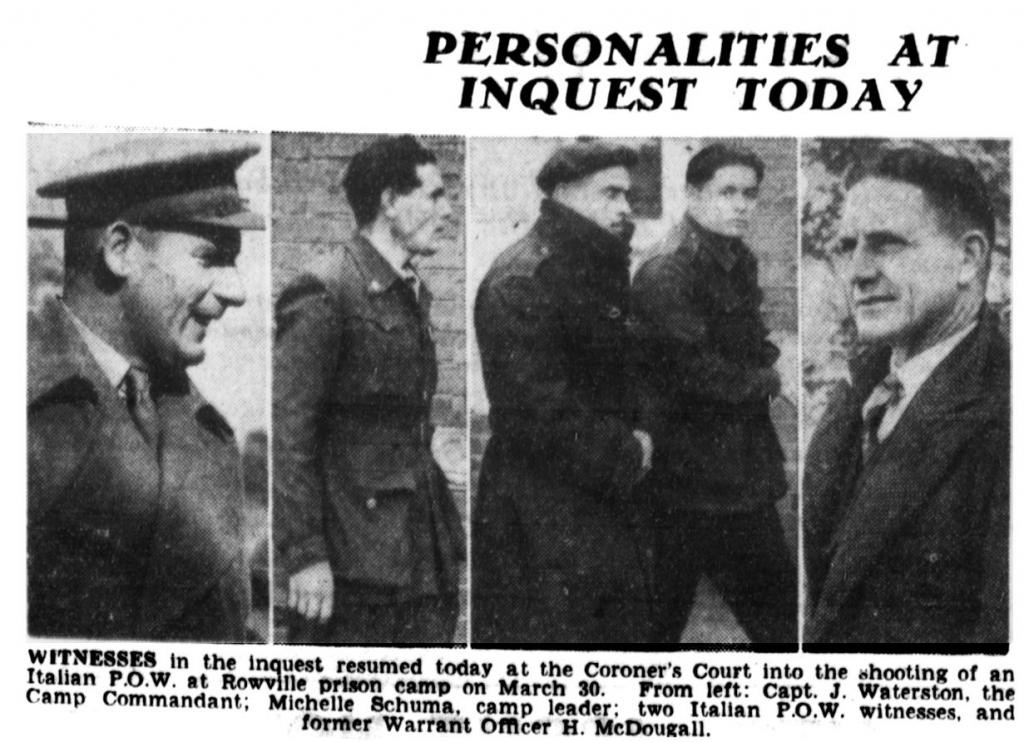
Among the documents in Bartoli’s inquest file is a handwritten statement from Captain Waterston taken by Homicide Detective Petty. The file also contains a haunting crime scene photograph showing Homicide Detective Adam standing at the location where Bartoli had been shot (Figure 8). This photograph was a key piece of evidence used in the coroner’s inquest and Justice Simpson’s inquiry into the camp, held several months later, as a reference point for witnesses to describe where they were standing and where they saw Bartoli and Captain Waterston at the time of the shooting.
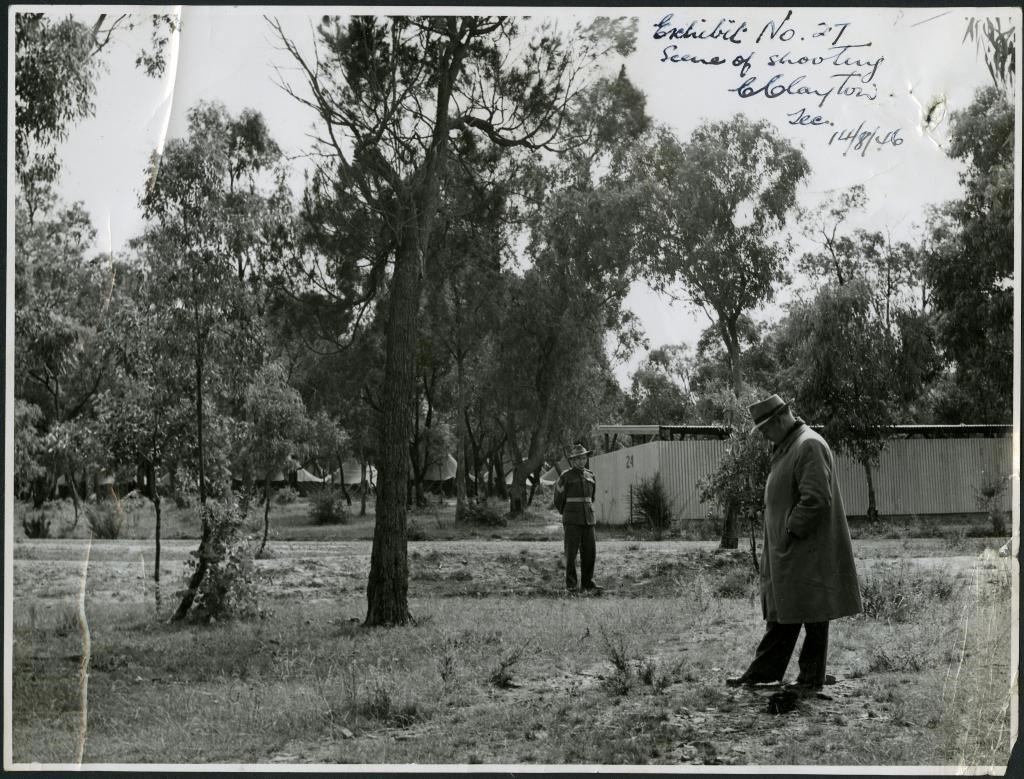
As the eyewitness accounts emerged, the explanation that Captain Waterston had shot the prisoner while attempting to foil an escape attempt began to show some discrepancies. It became apparent, both from the prisoners and the military personnel, that the instructions about the hostel boundaries were unclear. Apart from the map posted outside the orderly room after the shooting on 10 April, no formal announcement about camp boundary changes had been made.
Sergeant Major McDougal was the only witness who said that he heard a verbal warning and a warning shot. All the other witnesses heard no warning and only one shot. Several prisoners standing at their tents saw Bartoli walking calmly before falling to the ground after he was shot. The tents are visible in the background of the crime scene photograph. Only a minute or two before he was shot, Bartoli had been walking with hostel leader, Michele Scuma, who had gone into the latrine block, also visible in the photograph.
Captain Waterston could not account for the missing spent cartridges from his rifle or give a satisfactory explanation for blood stains that were found in a different location to where Bartoli had reportedly been shot. Nor was he able to explain why the bullet appeared to enter Bartoli’s body at an angle that suggested he was not where Waterston had indicated. Waterston said that Bartoli was carrying something concealed under his jacket but forgot to check for it. Those who helped to undress Bartoli to administer first aid said that he was not carrying anything.
The coroner found that ‘Rodolfo died from the effects of a gunshot wound of the abdomen inflicted on him by John Walker Waterston at Rowville prisoner of war camp on 30th March 1946 but from the evidence adduced I am unable to say whether the killing was justified or otherwise.’[25]
Confiscated items and missing iron sheets
On 14 May, the evening before the coroner’s inquest, as the prisoners were returning to the hostel on trucks from their day of work, Captain Waterston approached one of the trucks. He singled out Enrico Quintavalle, slapped him in the face and ordered him off the truck. Quintavalle was taken into Captain Waterston’s office with the hostel interpreter, Sergeant Holtham, and was questioned about a rumour regarding a large quantity of corrugated iron that had gone missing from the hostel after one of the buildings had been dismantled and was said to have been delivered to John Finn’s farm across the road from the hostel. Waterston had heard that Quintavalle had told another local farmer, John Gearon, that Waterston had shot Bartoli because he knew too much about Waterston’s arrangements with John Finn. Waterson forced Quintavalle to make a written statement, which was translated into English for Justice Simpson’s inquiry:
Mr Gearon asked me if I believed the Captain had shot Bartoli, because the latter knew too much about the Captain. I replied that I could say nothing about this, as I was not in strict confidence with Bartoli, I could not say what he knew about the Captain. Then Mr Gearon asked me if I knew anything about some of the iron sheets that were disappearing from the Camp, and if I believed that Bartoli, knowing where the iron sheets had gone had lost his life on that account. I replied, No, I know nothing about those iron sheets. Then he asked me if I had seen any iron sheets at the place where I went to work (Mr Finn), and I replied that there were some iron sheets there but I could not say whether the iron sheets were the same.[26]
Just days prior to Bartoli being shot, Nora Gearon had typed a letter for her father, John Gearon, that was sent to the authorities. Some of the prisoners had told John Gearon that Captain Waterston had been confiscating their possessions as they returned to the camp. The items included gifts and food they had been given while working on farms. The prisoners told John Gearon that Waterston was passing the confiscated items to John Finn who was then selling them at local markets and the Queen Victoria Market in Melbourne. To this day, Nora wonders if the letter she typed for her father ‘had some bearing on the matter’.[27]
Justice Simpson’s inquiry
Justice Simpson’s inquiry into the shooting and the hostel administration commenced on 28 May. The allegations in Louisa Santospirito’s letter were used as the terms of reference for the inquiry. The inquiry sat for a total of 19 days between 28 May and 16 August 1946 and 106 witnesses were heard. Justice Simpson’s report was completed on 26 August 1946.
Over the course of the inquiry, numerous accounts and allegations were heard of Captain Waterston assaulting prisoners, brandishing and firing his pistol at or near prisoners, being regularly intoxicated while on duty, and confiscating and not returning prisoners’ property. One of his own personnel reported that, while patrolling the hostel one night, he heard Captain Waterston say: ‘I want to see a dead eyetie tonight.’[28]
The final report, delivered to Minister Forde in October 1946, was highly critical of Captain Waterston and the hostel administration. Justice Simpson was satisfied with the evidence that the allegations of assaults on prisoners were true and that Captain Waterston frequently brandished and fired his revolver in and around the hostel. Justice Simpson stated: ‘I regret to have to report that in my opinion these slaps and occasional punches were not given in just moments of irritation, but were part of Captain Waterston’s methods of keeping discipline.’[29] He found evidence that Captain Waterston had failed to pass on written complaints from a former hostel leader, but found no evidence that prisoners were deprived of food.
Justice Simpson was not satisfied that Bartoli intended to leave the camp, either temporarily or permanently, on the night that he was shot. He stated that Bartoli was not out of bounds when he was shot and concluded that only a single shot had been fired.
Justice Simpson was critical of Captain Waterston’s superior officer, Captain Thomson, and his conduct during the inquiry: ‘I have no hesitation in saying that he was a witness who had no regard for the truth.’ He recommended that Captain Waterston, Captain Thomson and Major Ruddock, who had responsibility for regularly inspecting the camp, be removed from duty.[30]
The army expressed concern that, since censorship controls had been removed on prisoner of war correspondence, the criticisms made within the report could have ‘unfortunate results’. The report was marked as secret.[31]
Courts martial and charges laid
Justice Simpson conducted a thorough inquiry into the allegations against Captain Waterston, the administration of the camp and the shooting of Bartoli. He was clear in his findings about the misconduct that had taken place. Addressing the issues from Justice Simpson’s inquiry, the coroner’s inquest and the military court of inquiry, the army director of legal services laid nine charges against Captain Waterston and two charges against Captain Thomson. One of the charges against Captain Thomson was related to him firing his revolver in the officer’s mess at the dinner party after the military court of inquiry. Despite him admitting to doing this while giving evidence during Justice Simpson’s inquiry, he was found not guilty on both counts.[32]
Captain Waterston was found guilty of one of his nine charges—common assault against a prisoner, Enrico Quintavalle, for which he received a reprimand.[33] This was the only tangible punishment issued as a result of all of the investigations carried out.
The adjutant-general recommended that a note regarding the finding be placed on Major Ruddock’s service record. However, following a request by Major Ruddock and Southern Command that ‘certain derogatory’ remarks be removed from Ruddock’s record, the comments were expunged.[34]
The issue of the missing corrugated iron sheets being delivered to John Finn was briefly investigated by Victoria Police but not pursued. This is despite John Finn having been found guilty at the Dandenong Magistrates’ Court of receiving stolen goods from the Rowville hostel in July 1946, a matter that was not mentioned in any of the inquiries.[35]
Fortunately for Captain Waterston, Victoria Police notified the Australian military that they did not propose to take any further action against him in connection with the shooting incident. Whether Waterston shot Bartoli by accident or design may never be known.
After internment
Rodolfo Bartoli was buried at the Springvale cemetery on 2 April 1946. In 1961, his body was moved to the Ossario at Murchison cemetery where 130 people of Italian descent who passed away in prisoner of war and internment camps around the country during World War II are laid to rest. In December 1946 and January 1947, the surviving Italian prisoners, many of whom had been away from home for most of the war, began their journey home.
First published December 22, 2020, ‘Rowville’s Italian prisoners of war ’, Provenance: The Journal of Public Record Office Victoria, issue no. 18, 2020. ISSN 1832-2522. Copyright © Darren Arnott .
Darren Arnott is a Melbourne-based IT security consultant and is the author of No regard for the truth, shortlisted for the Victorian Community History Awards 2020. A former Rowville resident, he has an interest in local history and was intrigued by the story of the Italian prisoners of war. Darren conducted much of his research for this book at the Victorian Archive Centre and workshopped his manuscript as part of Hazel Edward’s ‘Complete your book in a year’ program at Public Record Office Victoria.
The article is a summarised version of the book, “No Regard for the Truth” which contains more detail about the history of the camp and the investigation into the shooting.
Endnotes
[1] NAA: MP742/1, 255/6/774 Part 1.
[2] Alan Fitzgerald, The Italian farming soldiers: prisoners of war in Australia 1941–1947, Melbourne University Press, Melbourne, 1981
[3] Ibid.
[4] NAA: MP742/1, 255/6/774 Part 1, in the matter of a reference by the Minister of State for the army in relation to the administration of Rowville Prisoner of War Control Hostel, and the circumstances resulting in the death of an Italian prisoner of war no. 48833 R. Bartoli.
[5] Bryan Power, ‘Brian Seymour remembers the friendly POWs at Rowville’, Rowville & Lysterfield Stories, Rowville–Lysterfield Community News, 2005.
[6] NAA: MP742/1, 255/6/774 Part 1, inquiry into the administration and matters surrounding the administration of the prisoner of war hostel, Rowville Victoria, transcript of evidence from Captain HJ Thomson, 28 May 1946.
[7] NAA: MP1103/1, PWI48833; NAA: MP1103/2, PWI48833.
[8] NAA: MP742/1, 255/6/774 Part 1, inquiry into the administration and matters surrounding the administration of the prisoner of war hostel, Rowville, Victoria, Mr Minogue, 15 July 1946.
[9] ‘Louisa Angelina (Lena) Santospirito’, Italian Historical Society, available at <https://www.coasit.com.au/santospirito-collection-louisa-angelina-lena-santospirito>, accessed 8 October 2020.
[10] NAA: MP742/1, 255/6/774 Part 1, Lena Santospirito to Arthur Calwell, 1 March 1946.
[11] NAA: MP742/1, 255/6/774 Part 1, inquiry into the administration and matters surrounding the administration of the prisoner of war hostel, Rowville, Victoria, transcript of evidence from Gerald Healy, 25 May 1946.
[12] NAA: MP742/1, 255/6/774 Part 1, Frank Sinclair to Adjutant-General Captain Waterston, POW Camp, Springvale, 21 March 1946.
[13] NAA: MP742/1, 255/6/774 Part 1, Adjutant-General to Southern Command, PWC Hostel – V22 Rowville, 27 March 1946.
[14] NAA: MP742/1, 255/6/774 Part 1, Southern Command Headquarters to Major HJ Archer, appointment as investigating officer into allegation of ill-treatment of PW at PWCH V.22 Rowville.
[15] PROV, VPRS 24/P0, Inquest Deposition Files, Unit 1547, Item 1946/1126, Rodolfo Bartoli, inquisition held at City Morgue – Melbourne – on the body of Rodolfo Bartoli 15 May 1946.
[16] ‘Army explains POW shooting case’, Herald (Melbourne), 1 April 1946, p. 7.
[17] Truth, 6 April 1946, p. 1.
[18] NAA: MP385/7, proceedings of court of inquiry assembled at Rowville, 5 April 1946.
[19] Ibid.
[20] Ibid.
[21] NAA: MP742/1, 255/6/774 Part 1, Frank Sinclair to Francis Forde, POW Camp – Rowville, 1 April 1946.
[22] NAA: MP742/1, 255/6/774 Part 1, inquiry into the administration and matters surrounding the administration of the prisoner of war hostel, Rowville, Victoria, Herbert James Thomson, 13 August 1946.
[23] NAA: MP385/7, Adjutant-General to Secretary for Minister, 18 April 1946, Captain Waterston – PW Control Hostel V.22 Rowville.
[24] NAA: MP742/1, 255/6/774 Part 1, Francis Forde to Secretary, death by shooting – PWI 48833, Bartoli, Rodolfo, 3 May 1946.
[25] PROV, VPRS 24/P0, Inquest Deposition Files, Unit 1547, Item 1946/1126, Rodolfo Bartoli, inquisition held at City Morgue – Melbourne – on the body of Rodolfo Bartoli, 15 May 1946, Detective Frederick John Adam and Detective Charles Herbert Petty.
[26] NAA: MP742/1, 255/6/774 Part 2, inquiry into the administration and matters surrounding the administration of the prisoner of war hostel, Rowville, Victoria, Enrico Quintavalle’s statement, exhibit 17.
[27] Nora O’Ryan (née Gearon) & Carmel Riddell (née Gearon), interview by Darren Arnott, 14 April 2019.
[28] NAA: MP742/1, 255/6/774 Part 1, inquiry into the administration and matters surrounding the administration of the prisoner of war hostel, Rowville, Victoria, Lee McCarthy, 12 August 1946.
[29] NAA: MP742/1, 255/6/774 Part 1, Justice Simpson’s final report, 27 August 1946.
[30] Ibid.
[31] NAA: MP742/1, 255/6/774 Part 1, Australian military forces minute paper, 5 September 1946 – Rowville enquiry – administration of prisoners of war.
[32] NAA: A471, 79310.
[33] NAA: A471, 79821.
[34] NAA: MP742/1, 255/6/774 Part 1, Adjutant-General to Secretary, Department of the Army, Rowville prisoner of war camp, 2 February 1947.
[35] ‘Twice-heard court case’, Dandenong Journal, 17 July 1946, p. 1.
Contact Darren Arnott about this article.
